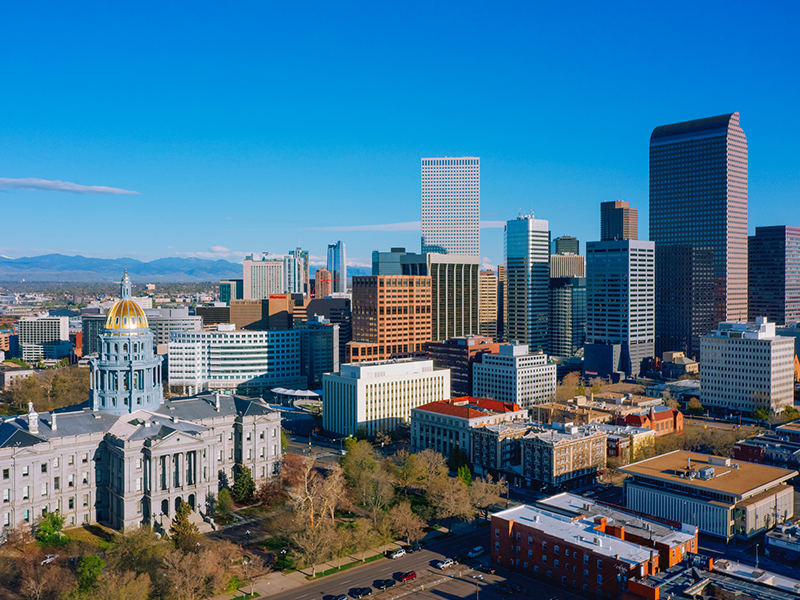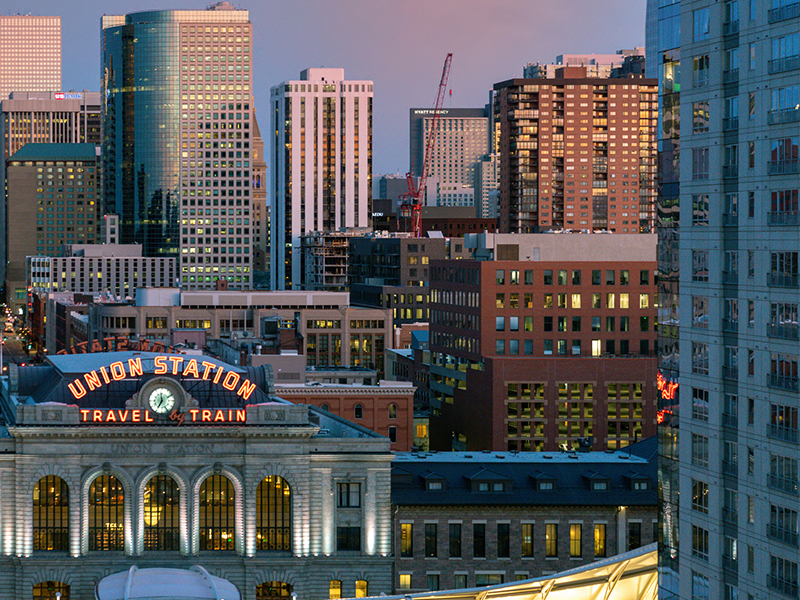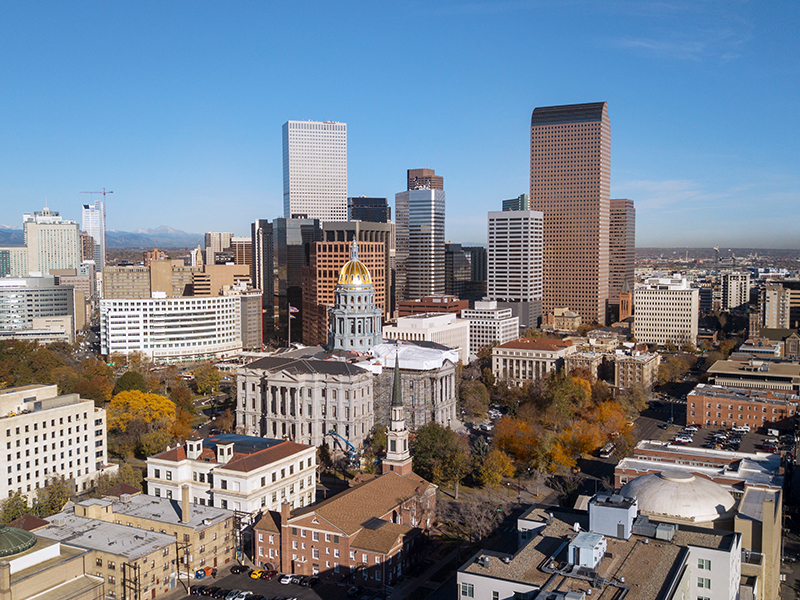
When it comes to historic neighborhoods and homes, few cities can compare to Denver, Colorado.
Nestled in the foothills of the Rocky Mountains, Denver is a thriving metropolis that over 700,000 residents now call home. Founded in 1858, the city is brimming with culturally significant neighborhoods that offer a glimpse into Denver’s past, as well as beautiful historic homes that have stood the test of time.
Ready to learn more? Put on your walking shoes, grab a map, and join me as I take you on a tour of some of the best neighborhoods in Denver, CO for historic homes.
Table of Contents:
DENVER’S MOST HISTORIC NEIGHBORHOODS

The Mile High City has come a long way since its founding as a mining town. Denver has traded its saloons, ranches, and trading posts for shopping malls, theaters, and skyscrapers. Despite its modernization, however, the city has retained many of its historic houses, buildings, and other landmarks— all of which are now proud fixtures in the neighborhoods they call home.
Here are some of the best neighborhoods in Denver, CO for historic homes.
Capitol Hill
Located in the heart of Denver, Capitol Hill dates back to the 1800s, making it one of the city’s oldest neighborhoods. Capitol Hill is primarily known for its stately Victorian and Queen Anne-style homes, many of which are still in use today. Capitol Hill also has a Bohemian flair and is especially valued for its lively arts and culture scene. Throughout the year, you’ll hear numerous art exhibitions and live music performances being hosted in this neighborhood.
Capitol Hill also provides easy access to downtown Denver, allowing residents and visitors to enjoy a variety of restaurants, bars, shops, and parks. Many of these spots are within walking distance of each other.
Some of the historic properties in Capitol Hill include Dunning-Benedict House and Molly Brown House, which now serves as a museum. You’ll also find important Denver landmarks here, such as the Colorado State Capitol and History Colorado Center.
Five Points
Those who wish to explore and experience Denver’s unique character will do well to check out Five Points. Considered one of the best neighborhoods in Denver, CO, Five Points was a vibrant hub for jazz and blues music and African American culture in the mid-20th century, leading residents and visitors to dub it the “Harlem of the West.”
Today, Five Points is a diverse community with a mix of trendy restaurants, bars, and shops, as well as historic mansions and landmarks. True to its roots, Five Points is home to several annual festivals and events, including the Five Points Jazz Festival and Juneteenth Music Festival, which celebrate the neighborhood’s rich culture and history.
Lower Downtown (LoDo)
Lower Downtown, also known as LoDo, isn’t an actual neighborhood per se, but it’s still a district worth exploring.
As one of the oldest settlements in Denver, it possesses a great selection of historic buildings that date back as early as the late 19th century. Some of these historic properties have been repurposed to house cafes, restaurants, and shops. Warehouses were also transformed into lofts and condos, some of which are on the higher end in terms of Denver real estate.
With its central location and mixed-use housing options, LoDo is a perfect choice for anyone who wants to make the most out of downtown living.
Highland
Located northwest of downtown Denver, Highland dates back to the late 1800s and is considered to be one of Denver’s first suburbs. It’s a pedestrian-friendly neighborhood, especially known for its beautiful Victorian homes and buildings. Some of the latter now house trendy restaurants, coffee shops, art galleries, and boutiques.
Highland is divided into three sections: Highlands Square, Lower Highland, and Tennyson Street. Highlands Square is said to be the original neighborhood in the area—it traces its origins to 1885. Historic homes that cover a wide time period abound. Apart from Victorian properties, you’ll also find Denver Squares, cottages, and Craftsman bungalows. The Victorian theme continues at Lower Highland and Tennyson Street, this time with older buildings housing apartments and condos.
But historic homes are not Highland’s only draws. This neighborhood has some of Denver’s most popular parks, including Sloan’s Lake Park and Highland Gateway Park.
Baker
Just south of Downtown Denver, the entire neighborhood of Baker is on the National Register of Historic Places. In 2000, it was also declared as one of the city’s historic districts and with good reason.
Baker is home to the largest collection of ornate Queen Anne-style homes in the city, as well as other offshoots of the Victorian design movement. Additionally, some of Baker’s historic homes are considered architecturally significant properties. Prominent Denver architects who left a lasting and indelible mark on the neighborhood include Marshall Pugh and William Lang, both of whom were proponents of Queen Anne architecture.
Mayan Theatre is one of the notable historic buildings in Baker. It features one-of-a-kind Art Deco and Mayan Revival architecture. Mayan Theatre was first opened as a movie house in 1930 and is now a renowned theatre for independent and foreign language films.
Curtis Park
Established in 1893, Curtis Park is filled with beautiful Victorian homes and historic landmarks, including the 1893-era Milheim House, which is listed on the National Register of Historic Places. Considered “Denver’s First Streetcar Suburb,” Curtis Park benefitted from reinvigoration programs started in the 1970s, leading it to become the vibrant urban neighborhood that it is today.
Historic homes in Curtis Park range from cozy townhomes to spacious mansions. And it’s not uncommon for these two property types to stand side by side. These buildings were built sometime between the 19th and early 20th centuries.
Washington Park
Washington Park, known locally as “Wash Park,” is located in south-central Denver. It’s best known for the park of the same name, which occupies almost the entire west section of Wash Park.
Restored Victorian properties and bungalows that date back to the early 20th century are plentiful in the neighborhood, along with more recent construction. Some of the historic homes in Wash Park include Eugene Field’s home at 715 S Franklin Street. Located on the same street is the Causey-Sterne House, which was built in 1913 and designed by Albert J. Norton and Willis A. Marean.
Although largely residential, Washington Park is close to a bevy of galleries, wine and cocktail bars, specialty shops, high-end clothing stores, and some of the city’s best local dining spots. All things considered, it’s easy to see why Wash Park is one of the best neighborhoods in Denver, CO.
Cheesman Park
Cheesman Park near Denver’s geographic center is perhaps the most interesting neighborhood in the city. It was first laid out in 1858, not as a residential area, but a cemetery. Prospect Hill, Denver’s first memorial park, to be exact. By the 1890s, there were approximately 5,000 bodies buried at Prospect Hill. The City of Denver eventually decided to turn the cemetery into a public amenity and removed the bodies from the premises. And so, Cheesman Park was born.
Some say Cheesman Park is haunted, but one thing’s for sure— the neighborhood is also home to a staggering number of historic properties set on tree-lined streets. These range from bungalows and apartment conversions to grand mansions. You can find almost every architectural style in Cheesman Park as well, from ubiquitous Denver Squares to handsome Dutch Colonial Revivals. All of these homes benefit from being in close proximity to the nearly 81-acre park in the heart of the neighborhood as well as Denver Botanic Gardens.
FREQUENTLY ASKED QUESTIONS ABOUT BUYING HISTORIC HOMES

What qualifies as a historic home?
Experts define historic homes as any property that is at least 50 years old and is known for having significant cultural, historical, or architectural value. These homes are often listed on local, state, or national historic registers, which provide protection and recognition for their historic significance.
What are the benefits of buying a historic home?
Historic homes possess architectural details that are not commonly found in newer homes, such as intricate moldings, stained glass windows, and ornate woodwork. But it’s the stories they tell that set them apart from more recent construction, making them a unique addition to any real estate portfolio.
Furthermore, owning a historic home comes with potential tax benefits, including tax credits and deductions for home renovations and repairs that preserve the home’s historic features. S cities and municipalities, such as Denver, offer tax incentives for homeowners who own and maintain historic and culturally significant homes.
What are the potential drawbacks of buying a historic home?
While historic homes do have numerous benefits, they can also be challenging to keep. Depending on their age and condition, historic homes may need more maintenance and upkeep. You may also have to tap the expertise of specialists, who may charge a premium for their services.
How do I know if a historic home is a good investment?
Historic homes are generally great additions to an investment portfolio, especially if they are well-maintained and located in desirable, high-value neighborhoods. Before signing contracts and handing signed checks, however, it is important that you do your research and work with a knowledgeable real estate agent to ensure that you are making an informed decision.
What should I look for when buying a historic home?
There are some things to consider when purchasing a historic home to ensure that you’re making a wise investment
- Condition of the house
- Signs of damage and decay
- The house’s history
- Potential zoning or landmark restrictions
- The location of the home
- Electrical, plumbing, and HVAC systems (or lack thereof)
How can I ensure that I’m buying a historic home?
Given the significance and value of historic homes and properties, it is important that you do your due diligence to ensure you’re getting the real deal.
First, try to research the home’s history and architectural style. You can look for original features like moldings, hardware, and flooring that match the home’s era. You can also pay the local library a visit— you may find more information about the home from public records.
Next, check if the home is listed on a historic register or has any special designations. If the home has been renovated, check to see if its updates have significantly altered the home’s character, which may bring down its overall value. Finally, try to hire a reputable home inspector who specializes in historic properties to thoroughly evaluate the home’s overall condition.
OWNING A DENVER HISTORIC HOME: LAWS & RULES TO REMEMBER

Denver has established a number of laws and regulations to help protect and preserve its historic homes and neighborhoods. They cover everything, from how to make alterations and additions to your historic home to tax credits and demolition reviews.
Here are some of the key regulations and guidelines for historic homes in Denver that you should be aware of:
- Historic properties must be used for their historic purposes. But you can also use them alternatively given that there’s minimal change to their defining characteristics. Furthermore, these historic characteristics must be preserved, not removed or altered.
- If your home’s historic features are in poor condition, they should be repaired instead of removed. But in the event that a certain feature is beyond repair, it must be expertly replaced by a matching replica. If you are replacing a missing feature, you must submit evidence (documentary, photographic, and/or physical) to the Denver Landmark Preservation Commission. If the home is also located in a designated historic district, the local association may also require you to submit these documents.
- If you’re making exterior alterations or adding features to the property, they must look like they belong to the time period when the house was originally built. It should also follow design and architectural guidelines. It’s a little strict, but these rules will help preserve the neighborhood’s (and Denver’s) heritage, not to mention property values.
- If your historic home can’t be saved and must be demolished, you need to submit an application to the city’s planning department. This is called the demolition review process. Part of the review explores alternative options to saving your historic home, as well as its significance to Denver’s history.
- As the owner of a historic property, you may be eligible for tax credits, which can help cover preservation and maintenance costs. Since the City of Denver wants the owners of historic properties to protect and preserve where possible, they’ve opened avenues so they can help you, too.
THE IMPORTANCE OF HIRING A HISTORIC HOMES SPECIALIST
Many people find the idea of purchasing a historic home exciting. After all, how often do you stumble upon a property with special provenance? But as we mentioned earlier, purchasing—and owning—a historic home, also comes with its own set of challenges. If you’re fully set on this endeavor, it’s best to work with a Historic Homes Specialist in Denver.
Here are some of the reasons why people should consider hiring a Historic Homes Specialist such as myself:
- They are experts on historic home design and architecture. There’ll be no guesswork when you work with a Historic Homes Specialist— they already know which architectural styles were prevalent in Denver, when they spiked in popularity, and what their design features are. Furthermore, they also know about the most common materials used for a given style or period. This skillset can help you assess whether the home you like is indeed a historic property and if it’s in good condition.
- They know the local rules and regulations. As mentioned earlier, Denver has several rules and laws in place to protect historic homes. You’ll have an easier time obeying these rules when you have a Historic Homes Specialist by your side. Additionally, they can also offer advice on how to get the required approvals and permits from the city.
- They have access to resources and other professionals. You’ll be able to tap into their network of professionals who know and understand the unique challenges and considerations that come with buying, selling, and owning historic homes. They include architects, contractors, and preservationists. With these contacts, you can make the most out of your investment and thoroughly enjoy your historic home.
FIND HISTORIC HOMES IN DENVER WITH ME, MARK MULLER
If you are in the market for historic homes in some of the best neighborhoods in Denver, CO, make sure to give me, Mark Muller, a call.
I am a licensed Denver Realtor under Coldwell Banker®, The Historic Denver Properties Group. I’m also a Pricing Strategy Advisor (PSA) and a Historic Homes Specialist with unrivaled experience and credentials. On top of that, I’ve been living in the Denver-Boulder area for more than 27 years. If you want an expert guide to historic homes in the best neighborhoods in Denver, CO, I’m your Realtor.
Let’s get started. Call us today at 303.941.6926 or send us an email to find historic homes for sale in Denver, Colorado.
